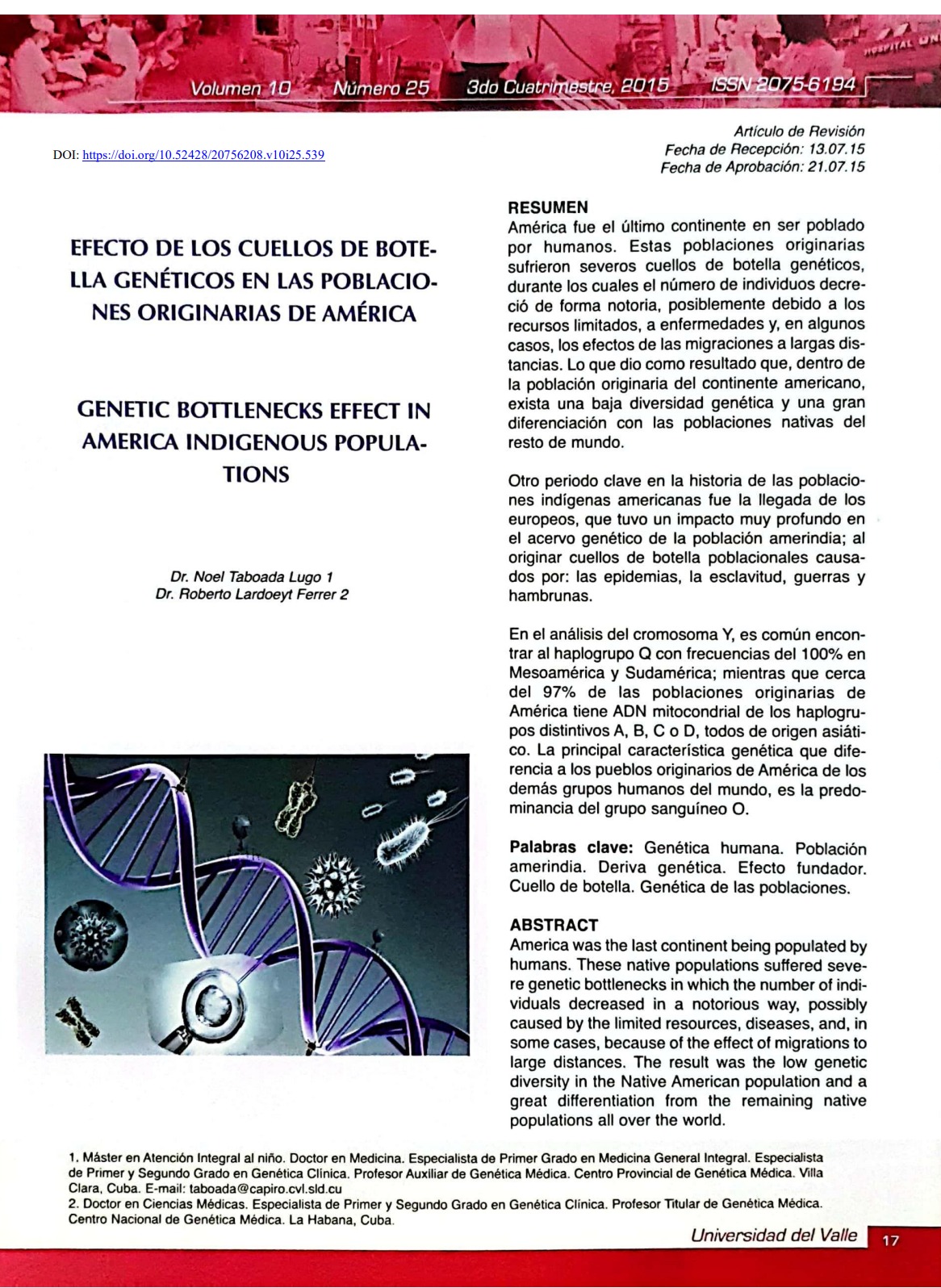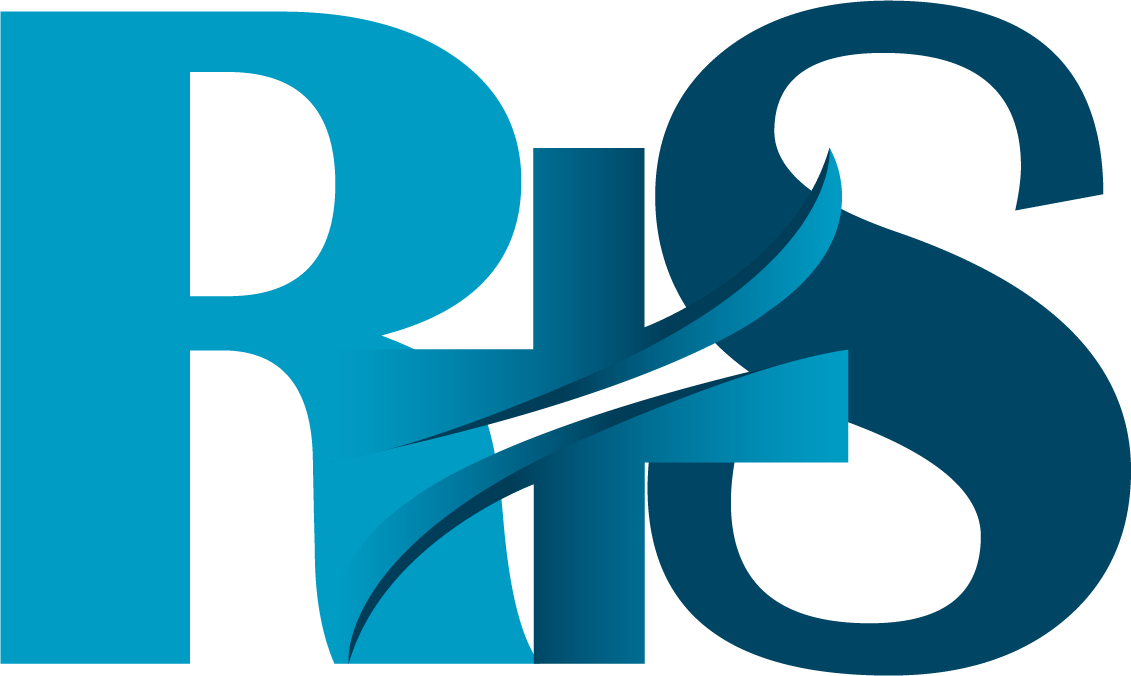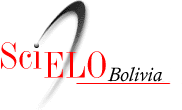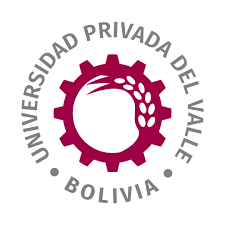Efecto de los Cuellos de Botella Genéticos en las Poblaciones Originarias de América
DOI:
https://doi.org/10.52428/20756208.v10i25.539Palabras clave:
Genética humana, Población amerindia, Deriva genética, Efecto fundador, Cuello de botella, Genética de las poblacionesResumen
América fue el último continente en ser poblado por humanos. Estas poblaciones originarias sufrieron severos cuellos de botella genéticos, durante los cuales el número de individuos decreció de forma notoria, posiblemente debido a los recursos limitados, a enfermedades y, en algunos casos, los efectos de las migraciones a largas distancias. Lo que dio como resultado que, dentro de la población originaria del continente americano, exista una baja diversidad genética y una gran diferenciación con las poblaciones nativas del resto de mundo. Otro periodo clave en la historia de las poblaciones indígenas americanas fue la llegada de los europeos, que tuvo un impacto muy profundo en el acervo genético de la población amerindia; al originar cuellos de botella poblacionales causados por: las epidemias, la esclavitud, guerras y hambrunas. En el análisis del cromosoma Y, es común encontrar al haplogrupo Q con frecuencias del 100% en Mesoamérica y Sudamérica; mientras que cerca del 97% de las poblaciones originarias de América tiene ADN mitocondrial de los haplogrupos distintivos A, B, C o D, todos de origen asiático. La principal característica genética que diferencia a los pueblos originarios de América de los demás grupos humanos del mundo, es la predominancia del grupo sanguíneo O.
Descargas
Citas
1 CABRERO J, CAMACHO JP. Fundamentos de Genética de Poblaciones. En: SOLER M. La base de la Biología, Granada: Proyecto Sur de Ediciones, S.L; 2003. p. 83-126.
2. KLUG WS, CUMMINGS M, SPENCER C. Conceptos de Genética. Madrid: Pearson. 8va ed. 2006.
3. STANLEY HA. Late Pleistocene human population bottlenecks, volcanic winter, and differentiation of modern humans. Journal Human Evol. 1998; 35:115-118.
4. HEY J. On the number of New World founders: A population genetic portrait of the peopling of the Americas. PLoS Biol.2005; 3:e193. https://doi.org/10.1371/journal.pbio.0030193
5. TAMURA K, NEI M. Estimation of the number of nucleotide substitutions in the control region of mitochondrial DNAin humans and chimpanzees. Mol Biol Evol. 1993; 10:512-526.
6. DIXON EJ. Human colonization of the Americas: Timing, technology and process. Qua! Sci Rev.2001; 20:2TT-299. https://doi.org/10.1016/S0277-3791(00)00116-5
7. RAY N . A statistical evaluation of models for the initial settlement of the American continent emphasizes the importance of gene flow with Asia. Mol Biol Evol.2010; 27:337-345. https://doi.org/10.1093/molbev/msp238
8. SCHURR T. The Peopling of the New World: Perspectives from Molecular Anthropology. Annu Rev Anthropol 2004. 33: 551-583. https://doi.org/10.1146/annurev.anthro.33.070203.143932
9. BATTILANA J, FAGUNDES NJR, HELLER AH, GOLDANI A, FREITAS LB. Alu insertion polymorphisms in Native Americans and related Asían populations. Annals Human Biol. 2006; 33(2): 142-160. https://doi.org/10.1080/03014460500487347
10. BATZER MA, DEININGER PL. Alu repeats and human genomic diversity. Nature Rev Genetics. 2002; 3,370-379. https://doi.org/10.1038/nrg798
11. SERILL J. Native American origins arose from multiple Bering Sea migrations. [Internet]. 2012 [citado 16 Mayo 2015]. Disponible en http://www.labgrab.com/users{jeffrey-serrill/blog/native-american-originsarose-multiple-bering-sea-migrations_id%3D 1339
12. FAGUNDES NJ, KANITZ R, BONATTO SL. A reevaluation of the native American mtDNA genome diversity and its b earing on the models of early colonization of Beringia. PLoS ONE.2008; 3:e3157. https://doi.org/10.1371/journal.pone.0003157
13. REICH D, PATTERSON N, CAMPBELL D, TANDON A, MAZIERES S, RAY N, et al. Reconstructing Native American population history. Nature. 2012; 488:370-374. https://doi.org/10.1038/nature11258
14. COCK SF, SORA WW. Essays in Population History: Mexico and the Caribbean, Vol. 111. Berkeley: University of California Press. 1979.
15. DEL POPOLO F, OYARCELAM. Población indígena de América Latina: perfil sociodemográfico en el marco de la CIPO y de las Metas del Milenio. CELADE-División de Población, CEPAL. [Internet]. 2005; [citado 16 Mayo 2015]. Disponible en: http://www.cepal.org/celade/noticias/paginasn/21237/delpopolo.pdf
16. UNICEF. Atlas sociolingüíslico de los pueblos Indígenas de América Latina. [Internet]. 2009 [citado 16 Mayo 2015]. Disponible en: http://www.proeibandes.org/atlas/tomo_1.pdf
17. Atlas poblacional de culturas amerindias. Instituto de Geofísica de la UNAM. [Internet]. 1999. [cita-do 16 Mayo 2015]. Disponible en: http://naolinco.igeofcu.unam.mx/atlas/pobl_cultur/ame_hoy.htm
18. FEHREN S. Diachronic investigations of mitochondrial and Y-chromosomal genetic markers in preColumbian Andean highlanders from South Peru. Ann Hum Genet.2011; 75:266-283.
19. CAREY M, PAIGEN B. Epidemiology of the American tndian's burden and it likely genetic origin. Am. J. Phys. Anthropol.2002; 36: 781-791. https://doi.org/10.1053/jhep.2002.36545
20. GIBBSONS D. Peopling of the Americas as infered through analysis of mtDNA. Genetics. 1993; 54:661- 668.
21. WATERS MR, STAFFORD TW. Redefining the Age of Clovis: lmplications for the peopling of the Americas. Science. 2007; 315 (15): 1122-1126. https://doi.org/10.1126/science.1137166
22. FAGUNDES NJ. Mitochondrial population genomics supports a single pre-Clovis origin with a coastal route far the peopling of the Americas. Am J Hum Genet. 2008; 82:583-592. https://doi.org/10.1016/j.ajhg.2007.11.013
23. DOBYNS H. Their number becomes thinned: Native American population dynamics in Eastern North America. Knoxville: University of Tennessee Press, 1983.
24. LIVI-BACCI M. The depopulation of Hispanic America after the conques!. Popul Dev Rev. 2006; 32:199-232. https://doi.org/10.1111/j.1728-4457.2006.00116.x
25. TATSUO A, MORENO O, VENTOSA-SANTAULARIA D. Decrecimiento de la población indígena durante la colonización española. ¿Enfermedad o explotación? lnv Econ. 2010; 69(272): 122-129.
26. SEMPAT AC. La despoblación indígena en Perú y Nueva España durante el siglo XVI y la formación de la economía colonial. Hist Mexicana, 1989; 38(3):419-453.
27. DEL CAMPILLO C. Las grandes epidemias en la América colonial. Arch Zootec. 2001; 50: 597-612.
28. MCNEIL WH. Plagues and People. New York: Anchor books Editions, 1998.
29. BARRY l. The Sirionos of eastern Bolivia: A reexamination. Hum Ecology. 1977; 5(2): 137-154. https://doi.org/10.1007/BF00889540
30. Encuentro Continental de los Pueblos Indios. [Internet]. 1990 [citado 16 Mayo 2015]. Disponible en: https//www.bibliojuridica.org/libros/2/667/11.pdf

Descargas
Publicado
Cómo citar
Número
Sección
Licencia
Derechos de autor 2015 Noel Taboada Lugo y Roberto Lardoeyt Ferrer

Esta obra está bajo una licencia internacional Creative Commons Atribución 4.0.
Los autores/as que publiquen en esta revista aceptan las siguientes condiciones:
- Los autores/as conservan los derechos de autor y ceden a la revista el derecho de la primera publicación, con el trabajo registrado con la licencia de atribución de Creative Commons 4.0, que permite a terceros utilizar lo publicado siempre que mencionen la autoría del trabajo y a la primera publicación en esta revista.
- Los autores/as pueden realizar otros acuerdos contractuales independientes y adicionales para la distribución no exclusiva de la versión del artículo publicado en esta revista (p. ej., incluirlo en un repositorio institucional o publicarlo en un libro) siempre que indiquen claramente que el trabajo se publicó por primera vez en esta revista.
- Se permite y recomienda a los autores/as a compartir su trabajo en línea (por ejemplo: en repositorios institucionales o páginas web personales) antes y durante el proceso de envío del manuscrito, ya que puede conducir a intercambios productivos, a una mayor y más rápida citación del trabajo publicado.






















